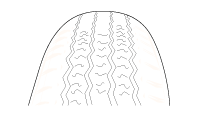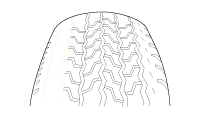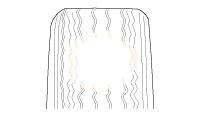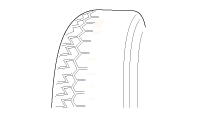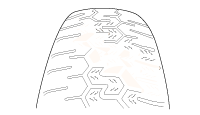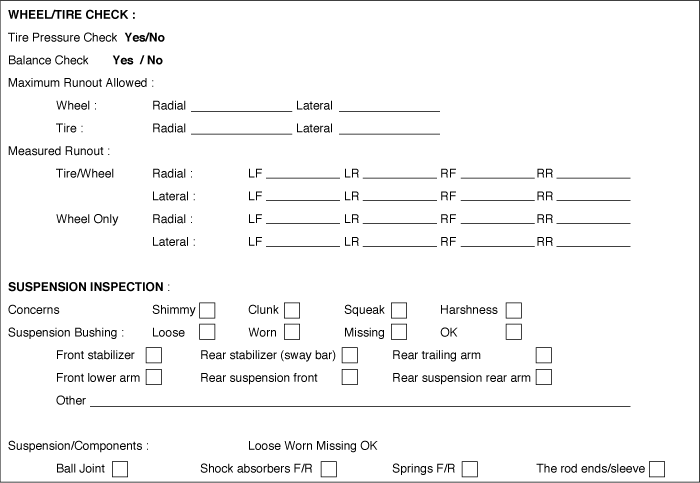To assist the service advisor and the technician, check the suspension and wheel/tire condition with the questions listed below by filling them. It serves as a place to record information as well as data from the testing to be carried out. To begin a successful diagnosis, fill out the questions.
Symptom | Suspect Area | Remedy |
Squeak or grunt-noise from the front suspension, occurs more in cold ambient temperatures - more noticeable over rough roads or when turning | Front stabilizer bar | Under these conditions, the noise is acceptable. |
Clunk - noise from the front suspension, occurs in and out of turns | Loose front struts or shocks | Inspect for loose nuts or bolts. Tighten to specifications. |
Clunk - noise from the rear suspension, occurs when shifting from reverse to drive | Loose rear suspension components | Inspect for loose or damaged rear suspension components. Repair or install new components as necessary. |
Click or pop - noise from the front suspension - more noticeable over rough roads or over bumps | Worn or damaged ball joints | Install new lower arm as necessary. |
Click or pop - noise occurs when vehicle is turning | Worn or damaged ball joints | Install new lower arm as necessary. |
Click or snap - occurs when accelerating around a corner | Damaged or worn Birfield joint | Repair or install a new Birfield joint as necessary. See DS group - driveshaft. |
Front suspension noise - A squeak, creak, or rattle noise - occurs mostly over bumps or rough roads | Steering components Loose or bent front struts or shock absorbers Damaged spring or spring mounts Damaged or worn arm bushings Worn or damaged stabilizer bar bushing or links | Go to detailed test A. |
Groaning or grinding - noise from the front strut, occurs when driving on bumpy roads or turning the vehicle | Uneven seating surface between the insulator and panel by the burrs around the strut insulator mounting bolts and the insulator bolts mounting holes | Repair or install a new parts as necessary. |
Rear suspension noise - a squeak, creak or rattle noise - occurs mostly over bumps or rough roads | Loose or bent rear shock absorbers Damaged spring or spring mounts Damaged or worn control arm bushings | Go to detailed test B. |
Shudder - occurs during acceleration from a slow speed or stop | Rear axle assembly mis-positioned Damaged or worn front suspension components | Check the axle mounts and rear suspension for damage or wear. Repair as necessary. Check for a loose stabilizer bar, damaged or loose strut/strut bushings or loose or worn ball joints. Inspect the steering linkage for wear or damage. Repair or Install new components as necessary. |
Shimmy - most noticeable on coast/deceleration - also hard steering condition | Excessive positive caster | Check the caster alignment angle. Correct as necessary. |
Tire noise - hum/moan at constant speeds | Abnormal wear patterns | Spin the tire and Check for tire wear. Install a new tire as necessary. Inspect for damaged/worn suspension components. Perform wheel alignment. |
Tire noise - noise tone lowers as the vehicle speed is lowered | Out-of-balance tire | Balance the tire and road test. Install a new tire as necessary. |
Tire noise - ticking noise, change with speed | Nail puncture or stone in tire tread | Inspect the tire. Repair or replace as necessary. |
Wheel and tire - vibration and noise concern is directly related to vehicle speed and is not affected by acceleration, coasting or decelerating | Damaged or worn tire | Go to detailed test C. |
Tire wobble or shudder - occurs at lower speeds | Damaged wheel bearings | Spin the tire and check for abnormal wheel bearing play or roughness. Adjust or Install new wheel bearings as necessary. See DS group - front/rear axle. |
Damaged wheel | Inspect the wheel for damage. Install a new wheel as necessary. |
Damaged or worn suspension components | Inspect the suspension components for wear or damage. Repair as necessary. |
Loosen wheel nuts | Check the wheel nuts. Tighten to specification. |
Damaged or uneven tire wear | Spin the tire and Check for abnormal tire wear or damage. Install a new tire as necessary. |
Tire shimmy or shake - occurs at lower speeds | Wheel/tire out of balance | Check for wheel balance. |
Uneven tire wear | Check for abnormal tire wear. Install a new tire as necessary. |
Excessive radial runout of wheel or tire | Perform a radial runout test of the wheel and tire. Install a new tire as necessary. |
Worn or damaged wheel studs or elongate stud holes | Inspect the wheel studs and wheels. Install new components as necessary. |
Excessive lateral runout of the wheel or tire | Perform a lateral runout test of the wheel and tire. Check the wheel, tire and hub. Repair or Install new components as necessary. |
Foreign materal between the brake disc and hub. | Clean the mounting surfaces of the brake disc and hub. See DS group - front/rear axle. |
High speed shake or shimmy - occurs at high speeds | Excessive wheel hub runout Damaged or worn tires Damaged or worn wheel bearings Worn or damaged suspension or steering linkage Brake disc or drum imbalance | Go to detailed test D. |
Drift left or right | Tires Steering linkage Alignment Base brake system | Go to detailed test E. |
Steering wheel | Alignment Steering linkage Front lower arm ball joint | Go to detailed test F. |
Tracks incorrectly | Rear suspension Caster | Go to detailed test G. |
Rough ride | Front strut and spring assembly Rear shock absorber and spring assembly | Go to detailed test H. |
Excessive noise | Front or rear stabilizer bar components Springs Suspension components Shock absorbers | Go to detailed test I. |
Incorrect tire wear | Tire or unbalanced wheels Tire inflation Strut Alignment | Go to detailed test J. |
Vibration | Wheel/tire Front wheel driveshaft(s) Steering system Strut and spring assembly Spring and strut mounting Front lower arm ball joint Front lower arm mounting bolt bushing Stabilizer bar bushings Wheel hubs and bearing Rear suspension arms and bushings | Go to detailed test K. |
Vehicle leans | Tire/wheel Vehicle load Suspension components Incorrect ride height | Inflate tires to specification. Redistribute the load as necessary. Visually inspect the suspention system. Correct the ride height as necessary. |
Poor steering returnability | High knuckle rotating torque Alignment | Go to detailed test E. |
Wheel /tire noise, vibration and harshness concerns are directly related to vehicle speed and are not generally affected by acceleration, coasting or decelerating. Also, out-of-balance wheel and tires can vibrate at more than one speed. A vibration that is affected by the engine rpm, or is eliminated by placing the transmission in Neutral is not related to the tire and wheel. As a general rule, tire and wheel vibrations felt in the steering wheel are related to the front tire and wheel assemblies. Vibrations felt in the seat or floor are related to the rear tire and wheel assemblies. This can initially isolate a concern to the front or rear.
Careful attention must be paid to the tire and wheels. There are several symptoms that can be caused by damaged or worn tire and wheels. Perform a careful visual inspection of the tires and wheel assemblies. Spin the tires slowly and watch for signs of lateral or radial runout. Refer to the tire wear chart to determine the tire wear conditions and actions

